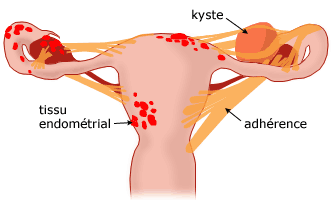Surgery of endometriosis
Progressive and almost always defined as endometrial by the presence of endometrium outside the uterine cavity
Endometriosis
Endometrial tissue develops outside the uterus. Every month, this tissue bleeds and gradually causes the formation of adhesions, scar tissue and cysts.

What is endometriosis?
It is a progressive and almost always mild disease defined by the presence of endometrium outside the uterine cavity. The endometrium is normally the inner lining of the uterus that grows during the cycle under the effect of female hormones. In the absence of pregnancy, the endometrium detaches from the uterus causing menstruation. In some patients, endometrium islets will implant outside the uterus into the abdominal cavity on the peritoneum, the surface of the uterus, the fallopian tubes, the ovaries, the bowel or bladder.
These implants will under the effect of female hormones, grow and then bleed which causes an inflammation of the affected organs, altering their function and creating pain. Endometriosis lesions are organised as implants, nodules or cysts.
A disease that comes from menstruation? Yes, partially.
During menstruation, most of the blood flows from the uterus into the vagina. However, there is also a blood flow from the uterus to the abdominal cavity through the tubes. This tubal reflux of menstrual blood is physiological, however in some patients, the endometrium which arrives in the abdominal cavity will, instead of being cleaned successfully take root and survive, thus creating endometriosis.
What are the main symptoms of endometriosis ?
Sometimes endometriosis is discovered incidentally during a laparoscopy performed for another reason. Otherwise, infertility and pain are the two major symptoms of endometriosis. A cyclical and premenstrual experience of pain is very suggestive of endometriosis.
The main possible symptoms are:
What is the treatment for endometriosis ?
The goal of treatment is twofold:
The treatment of endometriosis includes drug treatments and surgery by laparoscopy.
Key points of endometriosis surgery
Surgical treatment of endometriosis can sometimes be very delicate and absolutely must be performed by a qualified surgeon. Indeed, an incomplete initial or poorly performed surgery may cause persistent or worsening symptoms and greatly complicates any new surgery.
A careful clinical examination and imaging examinations (pelvic ultrasound and M.R.I) are useful before surgery, to establish a precise mapping of the lesions.
The goal of surgery is to remove most of the endometriosis lesions while leaving the affected and surrounding organs intact.
Moreover, as this surgery often involves women of childbearing age, it is crucial to preserve the reproductive potential of the patient as far as this is at all possible. For example, in cases of ovarian endometriotic cysts, removal of the cyst can cause a significant decrease in the ovarian reserve, and therefore we must be very careful with this procedure, especially if the patient wishes to conceive.
Digestive endometriosis
When endometriosis reaches the wall of the colon or rectum, there are two possible approaches:
Urinary endometriosis
Regarding endometriosis reaching the bladder wall, either the shaving technique can be performed, or a partial opening of the bladder can be made to remove the entire lesion. The bladder is then sutured, and generally heals very well.
If the lesion is very close to the ureters (the small pipes leading urine from the kidneys to the bladder), the procedure carries a higher risk of urinary complications. Pre- and intraoperative urological opinion may be necessary.
Thus, any surgery on the bowel or ureters requires close collaboration between the gynaecologist surgeon and the surgeons in the relevant specialty.





